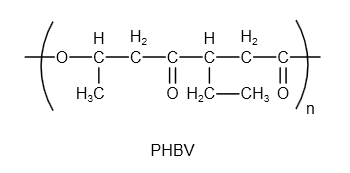Answer
35.1k+ views
Hint: Polymer is a substance or material made up of very large molecules or macromolecules made up of numerous repeating subunits. Natural and manmade polymers both play important parts in our daily lives due to their broad spectrum. Polymers are crucial to biological structure and function, ranging from synthetic plastics such as polystyrene to natural polymers and natural biopolymers such as protein and DNA.
Complete Step by Step Solution:
PHBV stands for Poly\[ - \beta - \]hydroxybutyrate-co\[ - \beta - \]hydroxyvalerate. It is a polyhydroxyalkanoate polymer of some sort. It is a non-toxic natural biodegradable plastic made by bacteria that can be utilised as an alternative to synthetic polymers.
The structure of PHBV is as follows:

Image: Structure of PHBV
Two (or more) types of monomer units are used to make a copolymer. Two (or more) types of monomer units can be found in the copolymer's repeating structural unit.
PHBV is prepared by the reaction as follows:

Image: Reaction to prepare PHBV
Therefore, PHBV is a copolymer of \[3 - \] hydroxybutanoic acid and \[3 - \]hydroxypentanoic acid.
Additional Information: Many bacteria, such as Paracoccus denitrificans, generate it naturally, and many genetically altered plants can also produce it. PHBV is a brittle thermoplastic polymer with poor elongation at break and limited impact resistance.
Note: Because of the geometry of the f-orbitals, the elements near the bottom of the group have f-subshell electrons that are diffused. They successfully shelter the s-electrons from the nucleus's attraction and render them bonding inactive.
Complete Step by Step Solution:
PHBV stands for Poly\[ - \beta - \]hydroxybutyrate-co\[ - \beta - \]hydroxyvalerate. It is a polyhydroxyalkanoate polymer of some sort. It is a non-toxic natural biodegradable plastic made by bacteria that can be utilised as an alternative to synthetic polymers.
The structure of PHBV is as follows:

Image: Structure of PHBV
Two (or more) types of monomer units are used to make a copolymer. Two (or more) types of monomer units can be found in the copolymer's repeating structural unit.
PHBV is prepared by the reaction as follows:

Image: Reaction to prepare PHBV
Therefore, PHBV is a copolymer of \[3 - \] hydroxybutanoic acid and \[3 - \]hydroxypentanoic acid.
Additional Information: Many bacteria, such as Paracoccus denitrificans, generate it naturally, and many genetically altered plants can also produce it. PHBV is a brittle thermoplastic polymer with poor elongation at break and limited impact resistance.
Note: Because of the geometry of the f-orbitals, the elements near the bottom of the group have f-subshell electrons that are diffused. They successfully shelter the s-electrons from the nucleus's attraction and render them bonding inactive.
Recently Updated Pages
If a wire of resistance R is stretched to double of class 12 physics JEE_Main

The path difference between two waves for constructive class 11 physics JEE_MAIN

What is the difference between solvation and hydra class 11 chemistry JEE_Main

IfFxdfrac1x2intlimits4xleft 4t22Ft rightdt then F4-class-12-maths-JEE_Main

Sodium chloride is purified by passing hydrogen chloride class 11 chemistry JEE_Main

Consider the following oxyanions PO43P2O62SO42MnO4CrO4S2O52S2O72 class 11 chemistry JEE_Main

Other Pages
The mole fraction of the solute in a 1 molal aqueous class 11 chemistry JEE_Main

What is the volume of water that must be added to a class 11 chemistry JEE_Main

when an object Is placed at a distance of 60 cm from class 12 physics JEE_Main

The correct IUPAC name of the given compound is A isopropylbenzene class 11 chemistry JEE_Main

What is the pH of 001 M solution of HCl a 1 b 10 c class 11 chemistry JEE_Main

Which of the following sets of displacements might class 11 physics JEE_Main



